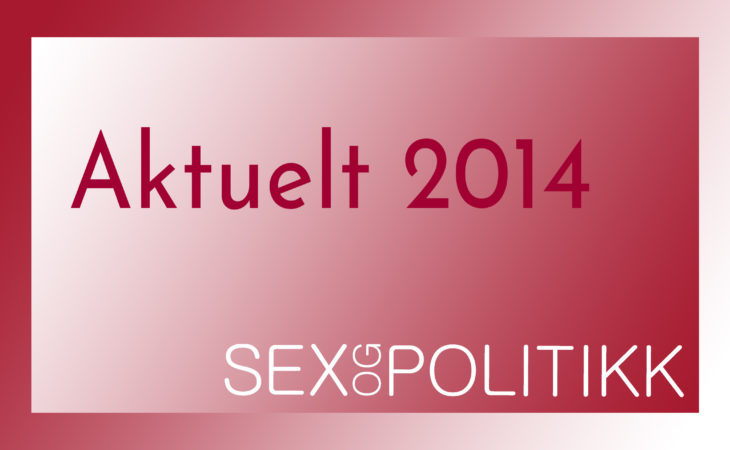WHO: Mangel på tjenester for å forebygge hiv

Sterke anbefalinger fra WHO
Publisert av WHO 11.07.2014
Failure to provide adequate HIV services for key groups – men who have sex with men, people in prison, people who inject drugs, sex workers and transgender people – threatens global progress on the HIV response, warns WHO. These people are most at risk of HIV infection yet are least likely to have access to HIV prevention, testing and treatment services. In many countries they are left out of national HIV plans, and discriminatory laws and policies are major barriers to access.
WHO today released «Consolidated guidelines on HIV prevention, diagnosis, treatment and care for key populations», in the lead-up to the International AIDS Conference in Melbourne, Australia, starting on 20 July.
Steps to reduce new HIV infections
The guidelines outline steps for countries to reduce new HIV infections and increase access to HIV testing, treatment and care for these five ‘key populations’*. They include a comprehensive range of clinical recommendations but, for these to be effective, WHO also recommends countries need to remove the legal and social barriers that prevent many people from accessing services.
For the first time, WHO strongly recommends men who have sex with men consider taking antiretroviral medicines as an additional method of preventing HIV infection (pre-exposure prophylaxis)** alongside the use of condoms. Rates of HIV infection among men who have sex with men remain high almost everywhere and new prevention options are urgently needed.
Modelling estimates that, globally, 20-25% reductions in HIV incidence among men who have sex with men could be achieved through pre-exposure prophylaxis, averting up to 1 million new infections among this group over 10 years. Studies indicate that women sex workers are 14 times more likely to have HIV than other women, men who have sex with men are 19 times more likely to have HIV than the general population, and transgender women are almost 50 times more likely to have HIV than other adults. For people who inject drugs, studies show the risks of HIV infection can be also 50 times higher than the general population.
«None of these people live in isolation,» says Dr Gottfried Hirnschall, Director of the HIV Department at WHO. «Sex workers and their clients have husbands, wives and partners. Some inject drugs. Many have children. Failure to provide services to the people who are at greatest risk of HIV jeopardizes further progress against the global epidemic and threatens the health and wellbeing of individuals, their families and the broader community.»
Continued global progress still needed
The guidelines are published as new figures underline the need for continued global progress on HIV. By the end of 2013, around 13 million people were taking antiretroviral therapy (ART), with 11.7 million of these people living in low- and middle-income countries. This has led to a 20% drop in HIV-related deaths between 2009 and 2012.
But while the number of people dying of AIDS is falling sharply, preventive efforts are still lagging too far behind, particularly among key populations.
There are still significant gaps in addressing their needs in national HIV plans. Globally, just 70% of countries surveyed explicitly address the needs of men who have sex with men and sex workers, while the figure for injecting drug users was 40%. Transgender people are rarely mentioned in HIV plans. And even where policies exist on paper, it is hard for people to access services that can help them.
Key populations are less likely to have equal access to HIV treatment. For example, in some settings in Eastern Europe, people who inject drugs make up more than half of all people living with HIV, but only one third of people living with HIV have access to lifesaving ART.
In many countries, discrimination is reinforced by laws that criminalize sexual behaviours, drug use, gender expression or perceived sexual orientation. However where laws and policies support access to HIV services for these key populations, illness and death due to HIV among these groups has declined and new HIV infection rates remain low or have fallen, especially among sex workers and for people who inject drugs.
«Bold policies can deliver bold results,» says Dr Rachel Baggaley, from WHO’s HIV Department. «Thailand was one of the first pioneers of programmes to recognise the need to keep sex workers healthy and reduce new HIV infection. Malaysia, Spain and the United Republic of Tanzania have made major advances in providing opioid substitution therapy and needles and syringe programmes for people who inject drugs. Data show that where a combination of effective HIV prevention and treatment services for people who inject drugs are available, HIV transmission among people who inject drugs is minimal.»
These new guidelines outline ‘comprehensive HIV packages’ for prevention, diagnosis, treatment and care for the five key populations and address specific issues and needs of adolescents from these groups. These include measures to better manage sexual and reproductive health, mental health and co-infections such as tuberculosis and hepatitis. They highlight the need for needle and syringe and opioid substitution therapy programmes and include recommendations for treatment of overdose in the community.
At the International AIDS Conference 2014 in Melbourne, WHO will call on governments to re-energize and strengthen HIV programmes so that all key populations benefit from the ongoing advances in HIV treatment and programme scale-up.
